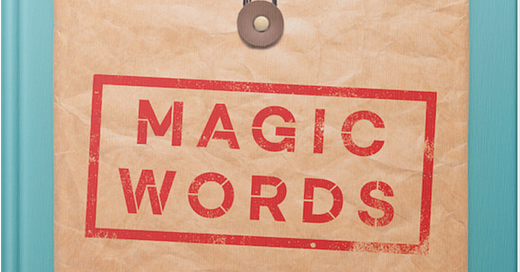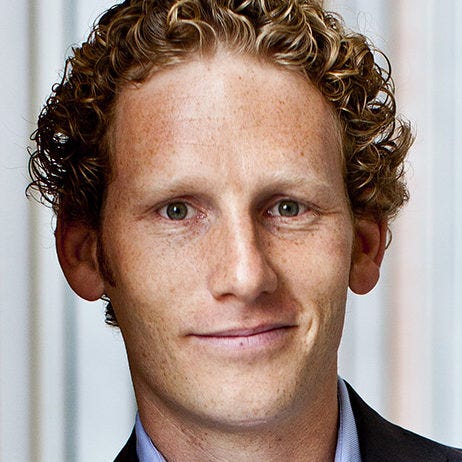Magic Words for Earning Attention
The expert on making ideas spread shares how he makes his own ideas spread. A very meta conversation with best-selling author and Wharton professor, Jonah Berger
Welcome to the Creativity Business, a newsletter about how to earn attention as a marketer or content creator. If you’re not a subscriber, sign up and get content strategy delivered to your inbox every two weeks for free.
Jonah Berger’s books about making ideas spread and changing people’s minds have been a strong influence on my thinking and how I approach strategy with clients. So it was a huge treat when he agreed to talk with me for the launch of his new book about the power of language, Magic Words, and how his research applies to the concept of Earning Attention.
Jonah is both a professor of Marketing at Wharton and a best-selling author, so I was very curious to hear how he put his own ideas and strategies into practice for the writing, packaging, and promotion of the new book.
Deconstructing Great Work
Unsurprisingly, Jonah is exceptionally thoughtful about how he approaches putting his work out. Through his lens as a social scientist, I love how he consciously deconstructs why things work and don’t work in order to do a better job of creating change and impact.
“When I wrote Contagious, I looked at all my favorite books and tried to reverse engineer what I thought the authors were doing that made them work. In some cases, I saw amazing strategies and I said, I don't think I can do that. I'm either not a good enough writer, or I don't think it's a good fit for me. But in other cases, I thought, oh, this looks interesting! I think I can do something like this.”
Jonah’s deep curiosity about which language strategies work best, why they work, and how to best implement them led to the creation of Magic Words. He even developed and worked with Natural Language Processing and text analysis tools to better understand how language choices impact attention and learning.
“My interest in natural language processing started in part by being an author and going, why is this working? And trying to analyze some of the content.
What's so interesting about language is that as viewers, listeners, and readers, we all recognize when something works. We all read a piece of content where we can't wait to turn the page or we watch a movie where we wonder what's gonna happen next.
But what's so neat about natural language processing and automated textual analysis and the data and tools that we have now - we can begin to scientifically study some of these things and try to put some structure to it, almost thinking about the math of a good story.”
Making Magic Words Contagious
Jonah literally wrote the book on how to make ideas spread, Contagious. And with a new book full of new ideas, I wanted to know how he used the theories from Contagious to create maximum impact for Magic Words.
Practical Value:
People share ideas when they contain practical value and useful information that can help others. This is because we all like to be helpful and to be seen as helpful. So a book full of useful, practical strategies about language should be ripe for sharing. ✅
Storytelling & Emotions:
Contagious also details why telling compelling stories to illustrate principles is much more effective than sharing facts and research findings on their own. Jonah has filled Magic Words with stories that are easy to remember and share with others. ✅
Making it Public:
However, it’s not as obvious how to utilize another key Contagious principle, Making It Public for a book - the more you design a product or idea to be visible publicly so that people can see others consuming it, the more likely it is that they will want to consume it, too. Berger has creatively thought about this problem, too.
“For example, what does the cover of the physical book look like, so that if someone's sitting on the subway or the plane reading it, are other people likely to see it publicly?” ✅
Social Currency:
Social Currency is when there is value in a person sharing information with others. People are more likely to share ideas that reflect their desired identity. In other words, people will share ideas if it makes them look smart, cool, funny, etc. Berger consciously uses Social Currency when writing a book, but also in promoting it.
“In terms of social currency, why are they going to want to tell somebody else about it? How is it going to make them look? Why are they going to want to post it on social to make themselves look good, and, as a result, talk about the book’s content?
And when I give presentations, I’m thinking about kind of what ideas and stories will travel. Can I identify bite-size nuggets that people can pass along to their own networks because they find it useful? Or it makes them look good? Or it helps them and others in their own lives? And, as a result, the idea spreads more widely.” ✅
Have You Asked These Questions of Your Content?
If you want to get people talking about your ideas, Berger has advice for criteria that passes the Contagious checkmarks:
Will this be easy for people to understand and apply?
Is it surprising or unexpected in a way that will generate social currency?
Have you used stories and emotions to bring your ideas to life in ways that are easy to remember and share?
Can you make your ideas or product consumption visible in public?
What is the context where people will come across this idea and is the message tailored to that context?
Have you thought about your specific audience and the ways that different mediums communicate ideas to them?
And again, think like a scientist, get curious, and analyze what you see working in the wild.
“Whenever I see someone else doing something, whether it's on stage or on the page, I'm always trying to think about why did it work and I try to deconstruct it to figure out what makes it so powerful.
I interviewed Guy Raz, who has a number of podcasts - one of my favorites is How I Built This - and he's just a great storyteller. Somebody recommended it and I would listen to it while I was running. And then I started asking - I'm really enjoying this, but why am I enjoying this? What about this is making it work?”
Workshop Your Material Like a Standup Comic
One technique Jonah mentioned for optimizing the presentation of your ideas isn’t in his books and I love it. Much like a standup comic preparing for a Netflix special taping, you should try to workshop your ideas in public to identify and hone the stories with the highest impact.
“I think a lot about standup comedians and the way that they use open mics to test material. That's a really interesting idea, right? Because it's not just whether the content is good, but whether the delivery is good.
You do something a few times, and it works better one time or works better another time. I think those experiences help sharpen it. And so it's always fun to take it on the road and try to get that feedback.”
The Idea is More Important Than the Story
Berger provides a final piece of advice - don’t focus on making language more powerful, or ideas more contagious, at the expense of the idea itself.
The entire point of making an idea spread or conveying an idea clearly is the idea itself. For example, Magic Words discusses how using personal stories and concrete ideas can make less exciting ideas more compelling.
“Personal stories with concrete details are always amazingly powerful, but you have to make sure that what people take away from the story is not just, wow, this was an amazing story, but I'm taking home the principle that you want me to take home.
Sometimes you find an amazing story, but the moral of the story isn't exactly what you want. And so it's almost more important to start with the moral, start with the end, figure out the end that you want to get to, and then use that to help you figure out the story that best illustrates that.”
Takeaways
I LOVE how much Jonah analyzes, reverse engineers, and deconstructs the work of others that he finds interesting. Paying attention to what earns your attention and asking why and how it works is something we should all strive to do more often.
Focus on the audience. Focus on the audience. Focus on the audience.
What filters are you applying to content you put out into the world? Are you actively considering factors that might drive word of mouth? Are you telling stories that are more or less likely to create change?
Can you start workshopping your stories and bite-size nuggets to see which ones work best, in which contexts, and why?
Pay attention to the end goal - don’t tell stories that aren’t going to deliver the result you’re looking for.
In part two of our conversation (in the next edition of this newsletter), Jonah digs into branded content and discusses how brands need to think differently to earn attention. He also shares research on how brands can communicate more effectively with their desired audiences.
What’s Earned My Attention Recently
Oatly is Earning Attention with an Unconventional Voice
Oatly and its unique marketing approach is earning a lot of attention, particularly from the highly unusual launch of a new email newsletter called Spam. Smart marketers like Ann Handley and Angela Matusik are noticing.
The Care and Feeding of Your Audience
Tom Webster is one of my favorite people in podcasting - an exceptionally nice and funny human who is also really smart. He recently wrote about the importance of learning about your audience and everything in here is bang on. As I wrote above in the Jonah takeaways - focus on the audience, focus on the audience, focus on the audience.
Ezra Klein is Focused on Attention
Ezra Klein is similarly obsessed with attention these days, and I enjoyed hearing him talk to Tim Hwang (author of Subprime Attention Crisis) about the $500 Billion Attention Industry and how it works.
Creator Educators and Microlearning
I love the idea of microlearning and also the laser focus on the Creator Educator group in The Creator Educator newsletter from Thinkific CEO, Greg Smith. Lots to think about and learn for creators and marketers in any medium.
Measuring Attention
Paul Rismandel from Signal Hill Insights wrote about an existing tool to measure earned attention. I can attest from having done a lot of this work with the Signal Hill team, the brand lift study is an exceptionally valuable tool.
This Business Card Goes to Eleven
Finally, the best business card I saw at Podcast Movement Evolutions came from Tony Mennuto at Wordsworth+Booth, with a Spinal Tap-esque quote. Several friends and I had a debate about whether this was real or a joke - apparently, it is indeed a joke and Tony has a comedy background. Tony wins because a group of us were talking about his BUSINESS CARD over dinner.












